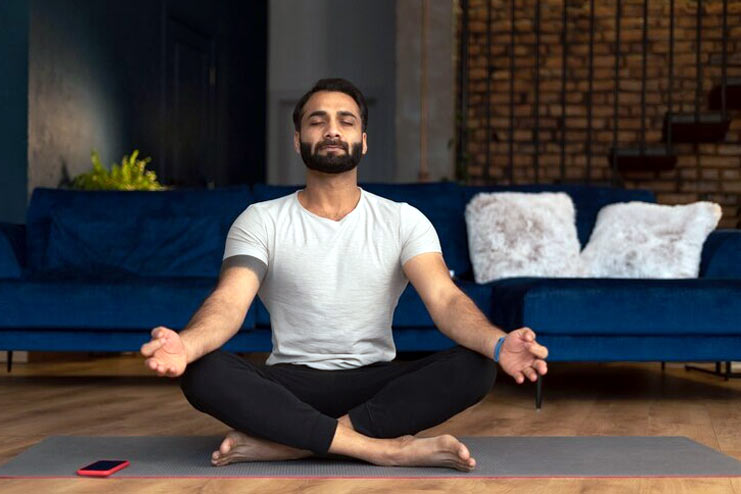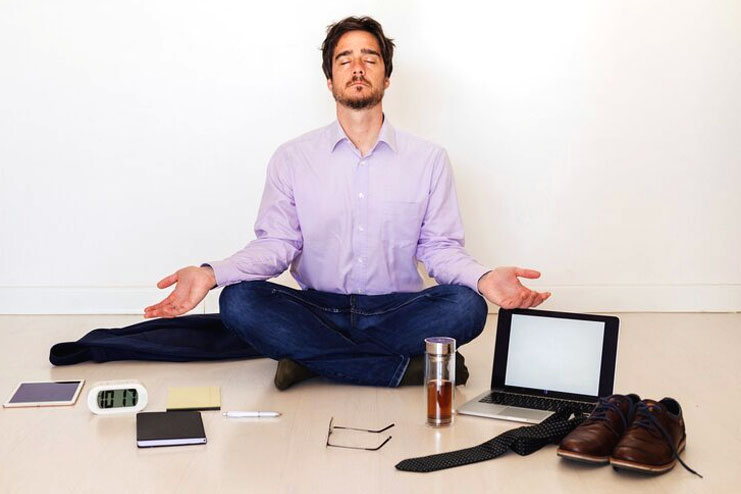Affiliate Disclaimer
Some links in this article are affiliate links. We may earn a small commission if you make a purchase through these links, at no extra cost to you. We only recommend products we find useful to our readersThe pressures of a busy lifestyle can hurt mental health in today’s fast-paced society. Recognizing the difficulties brought on by the nonstop activity is essential to resolving the effects on our mental well-being. In addition to introducing applicable mindfulness practices catering to busy men’s demands, this article seeks to shed insight into the particular problems these individuals face.
We aim to enable men to prioritize their mental health amid everyday chaos by exploring practical solutions that fit busy schedules. Come along with us as we explore finding balance and developing mindfulness in the middle of a busy life.
Understanding Mindfulness


A potent mindfulness technique is developing non-judgmental attention to the current moment while cultivating awareness. Its importance for bettering mental health stems from its capacity to ground people in the present moment and create a closer bond with their feelings and ideas. Mindfulness, which involves accepting and embracing the present moment without dwelling on the past or worrying about the future, is a valuable strategy for stress management and improving general well-being.
Including mindfulness in a hectic schedule has a lot of potential advantages. Amid everyday chaos, mindfulness offers a peaceful haven. According to research, regular mindfulness practice has been linked to improved focus, lower stress levels, and happier moods. Mindfulness practices become a game-changing way for busy guys to enhance their resilience and mental clarity while managing demanding work and personal obligations.
This section delves into the significant effects of mindfulness on mental health and reveals how it can work as a stabilizing force in the chaos of a busy lifestyle. Adopting mindfulness enables people to deal more calmly and efficiently with the difficulties a hectic schedule presents.
Mindful Breathing Techniques


One of the main components of mindfulness is conscious breathing, which is essential for bringing people into the present. Breathing meditation acts as an anchor by drawing attention away from outside distractions and encouraging a peaceful awareness. This deliberate awareness of breath can effectively counter the tensions of a hectic existence.
Try the following simple breathing exercises to start introducing mindful breathing into your everyday routine:
- Locate a Quiet Area: Decide on a peaceful setting where you may sit comfortably without being bothered.
- Sit Comfy: Sit comfortably with your shoulders relaxed and your back straight. Lay your hands over your lap.
- Focus on Your Breath: Shut your eyes or keep a gentle glance as you concentrate on your breathing. Focus on your breathing and take note of your natural inhalation and exhalation.
- Counting Breaths: Breathe deeply through your nose while silently counting to four. Breathe out from your mouth while counting to six. To create a rhythm that seems natural, adjust the count.
- Observation with mindfulness: As you inhale and exhale, pay attention to the feeling of air entering and exiting your body. With every breath in and breathe out, be present.
- Bring your attention back to the breath: If your thoughts stray, do so slowly. Thoughts will naturally come; the important thing is to notice them without passing judgment and focus elsewhere.
Quick Mindfulness Practices for Daily Life


Finding moments of mindfulness amid daily chaos can be life-changing. Extended sessions are only sometimes necessary to integrate mindfulness into regular activities; little, deliberate practices can significantly impact general well-being. Easily include the following helpful mindfulness practices in your routine:
Mindful Walking: Turn your everyday stroll into a mindfulness exercise with Mindful Walking. Observe every stride you take, the feel of your feet hitting the ground, and the cadence of your motion. Take in the sights, sounds, and fragrances around you to activate your senses.
Mindful Eating:
- During meals, stop and enjoy every taste.
- Pay attention to flavors, textures, and the scents of your food.
- Chew slowly and acknowledge the nourishment your body is receiving.
A routine task can become a thoughtful ritual with this easy action.
Short Mindfulness Pauses: Spread out your daily mindfulness practices throughout the day. For a few minutes, set a timer and utilize that time to be in the present moment, pay attention to your breath, or examine your surroundings. These little breaks can act as anchors, helping you stay grounded in hectic scheduling demands.
Mindfulness Meditation for Busy Schedules


Making time for mindfulness meditation throughout busy days can have a very significant and positive impact on mental health. Regular practice has enhanced overall resilience, increased focus, and reduced stress.” Given that busy guys have limited time, creating a brief yet efficient meditation regimen is critical to reap these benefits.
The benefits of mindfulness meditation regularly include improved self-awareness, better emotional control, and an enhanced ability to deal with the pressures of a busy lifestyle. Practicing non-judgmental awareness of the present moment can create a sense of serenity and clarity in the middle of chaos.
5-Minute Guided Meditation as a Condensed Meditation Routine:
- Locate a Quiet Area: Make sure you are in a peaceful area where you can sit down and relax for a short while without being disturbed.
- Sit Comfy: Take a comfy seat and maintain a straight back. Place your hands on your lap with your palms facing up or down.
Concentrate on Breath:
- Shut your eyes or keep your gaze lightly level.
- Focus on the breath you are taking.
- Take a deep breath through your nose and count to three.
- Count to four while exhaling through your lips.
Body Scan: Direct your attention to various body parts, beginning at your toes and ending at the top of your head. Acknowledge any tension or feelings without judgment and give them space to subside.
Go Back to Breath:
- Refocus your thoughts on your breathing.
- Pay attention to every breath in and breath out.
- Gently bring your thoughts back to breath if they stray.
Closing with Gratitude: As you open your eyes, take a minute to express your gratitude for the meditation. Think back to a happy experience you had.
Mindful Work Practices


Bringing mindfulness into the workplace can promote a culture of well-being, increase productivity, and reduce stress in the hectic world of work. Here are some concrete suggestions for time-pressed professionals, as well as a deeper examination of the use of mindfulness in the workplace:
Application of Mindfulness in the Workplace: Mindfulness at work entails developing a keen awareness of the here and now, which enables people to interact with tasks more skillfully while preserving equilibrium. This technique has been demonstrated to lower stress, improve decision-making, and create a happy work environment.
Advice for Including Mindfulness in Workplace Tasks:
- Start the Day with Mindful Breathing: Before starting any tasks, take a few minutes to focus yourself through mindful breathing.
- Single-Tasking: Concentrate on a single task at a time rather than multitasking, which can cause stress and reduce productivity.
- Mindful Meetings: Start meetings with a quick mindfulness practice to bring everyone together and increase participation.
- Scheduled Mindfulness Breaks: Spread out your day’s mindful breaks over a brief period. Pause, inhale, and reset for a moment.
Controlling Tension and Enhancing Attention:
- Mindful Stress Management: Pause mindfully as tension starts to build. Breathe deeply, accept the tension without judgment, and tackle the matter more lucidly.
- Mindful Reaction, Not Reaction: Breathe briefly and carefully consider your reaction before answering emails or dealing with difficult situations.
- Mindful Lunch Breaks: Lunch breaks can be used to eat deliberately, relishing each bite and providing a mental respite from work-related responsibilities.
Creating Mindful Habits


Developing mindfulness practices is a life-changing process that calls for perseverance and commitment. It is impossible to overestimate the significance of integrating mindfulness into everyday activities since frequent practice is necessary to reap the profound advantages of this mindful living properly.
The Significance of Consistency: Mindful habit formation relies heavily on consistency. People get comfortable and familiar with mindfulness activities by incorporating them into their daily lives. Consistent increases the likelihood that mindfulness will become ingrained in a person’s daily life and strengthens neurological pathways. Whether through morning practices, midday breaks, or nighttime meditations, adding mindfulness makes it possible to make a long-lasting change toward a more balanced and present-day life.
Suggestions for Including Into Everyday Activities:
- Start Small: Take small, doable steps toward practicing mindfulness. It can be as simple as doing a quick appreciation meditation before bed or practicing mindful breathing for a few minutes each morning.
- Anchor to Current Routines: Incorporate awareness into current practices. For instance, add mindful walking into your regular strolls or practice mindful eating during meals.
- Set Reminders: To promote a regular rhythm of mindfulness, use cues like alarms or calendar reminders to trigger thoughtful moments throughout the day.
- Have patience: It takes time to form thoughtful habits. Accept the process, and don’t let infrequent mistakes demotivate you. Consciousness in every moment helps create long-lasting habits.
Mindfulness Apps and Resources


The need for mindfulness apps and online tools has increased in today’s fast-paced world as people look for practical solutions to reduce stress and promote mental health. Numerous platforms and apps have surfaced, providing approachable and intuitive methods of incorporating mindfulness into everyday life.
From novices to seasoned practitioners, these mindfulness apps and services serve various consumers. By offering guided mindfulness activities, they assist users in becoming more resilient and self-aware in the face of adversity. The ease of use of smartphones and internet connectivity has made these gadgets indispensable allies in pursuing mental well-being.
Among many choices, Headspace, Calm, and Insight Timer are notable mindfulness apps and platforms. For example, Headspace provides guided meditations, mindful activities, and sleep aids that target different facets of mental wellness. To encourage relaxation, Calm offers a variety of breathing techniques, meditation sessions, and calming music. One of the main features of Insight Timer is its extensive collection of guided meditations taught by knowledgeable teachers from around the world.
Using these applications can be a life-changing experience for people starting a mindfulness journey. People can access many resources to cultivate resilience, mindfulness, and a more profound sense of inner Calm with a few simple clicks.
Mindfulness in Stressful Situations


When faced with unavoidable problems, mindfulness is an effective tool for stress management and handling high-pressure circumstances. Fundamentally, mindfulness is learning to live in the present moment with more awareness, which enables people to handle stressful situations calmly and clearly.
The key to practicing mindfulness under challenging situations is accepting and recognizing your feelings without passing judgment. People can escape the loop of worrying about the future or dwelling on the past by concentrating on the here and now. This increased consciousness offers a valuable viewpoint that makes it possible to react to difficult situations more carefully and moderately.
People can use a variety of tactics to use mindfulness practices in high-stress situations. A helpful strategy is mindful breathing, which involves focusing on the breath to center oneself in the here and now. Incorporating brief mindfulness techniques, like body scans or fast meditations, can also aid in mental reset and stress reduction.
Reframing negative thoughts through a mindful lens is another helpful strategy. People can change their viewpoints and cultivate a more positive and balanced mindset in the face of hardship by analyzing their ideas objectively and challenging their integrity.
In the end, bringing mindfulness into high-stress circumstances enables people to overcome obstacles with grace and resilience, promoting a stronger sense of control and well-being in the face of pressures from life.
Mindfulness for Improved Sleep


More people see the close relationship between better sleep and mindfulness as they look for more holistic ways to improve their health. With its emphasis on present-moment awareness, mindfulness helps encourage Calm and higher-quality sleep.
The pressures and rushing thoughts that frequently cause sleep disruptions are addressed with mindfulness. People can facilitate a calm and peaceful transition into a good night’s sleep by focusing on the here and now. Studies indicate that mindfulness can lessen insomnia symptoms and enhance general sleep patterns.
Simple exercises can profoundly affect people seeking to improve their sleep through mindfulness at night. Mindful breathing, which focuses on inhalation and exhalation, can help reduce anxiety and promote relaxation. The body can be effectively ready for sleep by progressive muscle relaxation, which releases tension from different muscular groups.
Before going to bed, mindfulness meditation, especially when developing compassion or thankfulness, can help you think positively. It reduces stress and creates a calm mental atmosphere ideal for a more restful night’s sleep.
Adding mindfulness exercises to bedtime routines is a simple and organic way for people who want to sleep better. People can develop a more profound sense of general well-being and improve their sleep quality by encouraging a thoughtful approach to nighttime.
Overcoming Common Mindfulness Challenges


Starting a mindfulness journey can be transformative, but it has its share of difficulties, just like any other discipline. Maintaining a meaningful mindfulness practice requires acknowledging and resolving these challenges.
The difficulty of finding time amid a busy schedule is one frequent problem. Setting aside even a short period for mindfulness can be difficult when faced with demanding obligations. Mindfulness may be made more manageable and lasting by incorporating it into regular tasks. A few examples of this include taking brief meditation breaks or practicing mindful breathing while commuting.
The tendency of the mind to wander during meditation is another challenge. The mindfulness approach includes acknowledging and gently refocusing attention on the present moment rather than seeing this as a setback. Accepting the rise and fall of ideas cultivates a non-judgmental mindset necessary for development.
While consistency is essential, some people could become demoralized if they miss a session. It’s critical to keep in mind that practicing mindfulness is a process rather than a goal. Rather than moping over slip-ups, please take advantage of them to get back on track and experiment with different mindfulness practices that work for you.
It’s also essential to practice patience. Though the cumulative effects of mindfulness take time to manifest, immediate advantages might not be noticeable. Reward little successes and recognize the beneficial impact on mental health to promote a resilient and long-lasting mindfulness practice.
Conclusion
Adopting mindfulness can be a life-changing experience for busy guys juggling the rigors of contemporary life. Accessible entrance points to mindfulness include critical practices like cultivating a non-judgmental awareness, finding brief periods for meditation in the middle of chaos, and incorporating mindful breathing into daily routines.
People can improve their resilience, handle stress, and improve their general well-being by incorporating these techniques. I urge readers to set out on this path, understanding that even little efforts in the direction of mindfulness can have a significant positive impact and lead to a more contented and balanced existence.
Other Related Articles:
References
- https://www.mentalhealth.org.uk/explore-mental-health/publications/how-look-after-your-mental-health-using-mindfulness
- https://www.apa.org/monitor/2012/07-08/ce-corner
- https://newsinhealth.nih.gov/2012/01/mindfulness-matters
- https://www.healthline.com/health/mind-body/conscious-breathing
- https://psychcentral.com/health/mindful-breathing
- https://www.betterhealth.vic.gov.au/health/healthyliving/breathing-to-reduce-stress
- https://www.mindful.org/take-a-mindful-moment-5-simple-practices-for-daily-life/
- https://moniquetallon.com/10-simple-ways-to-practice-mindfulness-in-our-daily-life/
- https://mindfulminutes.com/11-easy-ways-to-practice-mindfulness-in-your-daily-life/
- https://www.nccih.nih.gov/health/meditation-and-mindfulness-what-you-need-to-know
- https://newsinhealth.nih.gov/2021/06/mindfulness-your-health
- https://www.apa.org/monitor/2012/07-08/ce-corner
- https://positivepsychology.com/mindfulness-at-work/
- https://www.forbes.com/sites/forbeshumanresourcescouncil/2020/10/05/increasing-mindfulness-in-the-workplace/?sh=66f6071f6956
- https://www.mindful.org/how-to-change-your-habits-with-mindfulness/
- https://livewellflow.com/developing-consistency-when-creating-new-habits/
- https://medium.com/@navigatewithnilakshi/why-consistency-matters-so-much-during-habit-formation-f817d2fb061d
- https://www.ncbi.nlm.nih.gov/pmc/articles/PMC9444703/
- https://in.mashable.com/social-good/16527/13-great-apps-for-learning-about-mindfulne
- https://plumvillage.org/mindfulness/mindful-apps
- https://www.takingcharge.csh.umn.edu/mindfulness-stress-reduction
- https://mindfulness.com/stress/mindfulness-for-stress-reduction
- https://www.skillsyouneed.com/rhubarb/manage-stress-with-mindfulness.html
- https://www.sleephealthfoundation.org.au/sleep-topics/mindfulness-and-sleep
- https://www.ncbi.nlm.nih.gov/pmc/articles/PMC6557693/
- https://www.sleepfoundation.org/meditation-for-sleep
- https://www.mindful.org/overcome-these-five-common-obstacles-to-meditation/
- https://www.mayoclinic.org/healthy-lifestyle/consumer-health/in-depth/mindfulness-exercises/art-20046356






























